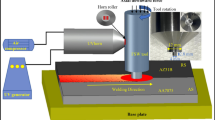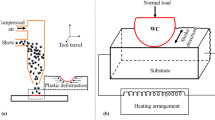Abstract
In this work, the microstructure and mechanical behavior of friction stir-welded 2-mm-thick sheets of Ti–6Al–4V alloy were investigated. Specifically, the influence of friction stir welding (FSW) process parameters on microstructure evolution, defect generation, tensile, and hardness properties of the joint were studied. Optical and scanning electron microscopies were used to examine the microstructure and to determine the type and nature of the defects. A progressive change in the microstructure from equiaxed and elongated α grains (base metal) to a very fine lamellar structure with an average grain size of less than 1 μm (in the upper stir zone) was observed and related to FSW parameters. Tensile tests and microhardness measurements were also carried out to assess the mechanical properties. Important variations were observed on tensile strength and hardness distribution as a function of process parameters. The weakest mechanical properties and fracture were found in the heat-affected zone (HAZ) of the as-welded joints. The results were analyzed in terms of the pseudo heat index, and it was determined that tool rotation is the most significant process parameter influencing both the microstructure and mechanical properties of FSWed Ti–6Al–4V joints.
Similar content being viewed by others
References
Lütjering G, Williams JC (2003) Titanium, vol 2. Springer, Berlin
Zwicker U (2007) Titanium and titanium alloys. Springer-Verlag, Berlin
Saresh N, Gopalakrishna Pillai M, Mathew J (2007) Investigations into the effects of electron beam welding on thick Ti–6Al–4V titanium alloy. J Mater Process Technol 192:83–88
Thomas WM, Nicholas ED (1997) Friction stir welding for the transportation industries. Mater Des 18(4):269–273
Sanders DG et al (2008) Characterization of superplastically formed friction stir weld in titanium 6Al-4 V: preliminary results. J Mater Eng Perform 17(2):187–192
Thomas WM, Threadgill PL, Nicholas ED (1999) Feasibility of friction stir welding steel. Science and Technology of Welding & Joining 4(6):365–372
Mishra RS, Mahoney MW eds (2007) Friction stir welding and processing. ASM international
Lee W-B et al (2005) Microstructural investigation of friction stir welded pure titanium. Mater Lett 59(26):3315–3318
Semiatin SL, Seetharaman V, Weiss I (1999) Flow behavior and globularization kinetics during hot working of Ti–6Al–4V with a colony alpha microstructure. Mater Sci Eng A 263(2):257–271
Edwards P, Ramulu M (2009) Effect of process conditions on superplastic forming behaviour in Ti–6Al–4V friction stir welds. Science and Technology of Welding & Joining 14(7):669–680
Ding R, Guo ZX, Wilson A (2002) Microstructural evolution of a Ti–6Al–4V alloy during thermomechanical processing. Mater Sci Eng A 327(2):233–245
Mehta KP, Badheka VJ (2016) Effects of tilt angle on the properties of dissimilar friction stir welding copper to aluminum. Mater Manuf Process 31(3):255–263
Sevvel P, Jaiganesh V (2015) Effect of tool shoulder diameter to plate thickness ratio on mechanical properties and nugget zone characteristics during FSW of dissimilar Mg alloys. Trans Indian Inst Metals 68(1):41–46
Afrin N et al (2008) Microstructure and tensile properties of friction stir welded AZ31B magnesium alloy. Mater Sci Eng A 472(1):179–186
Tongne A et al (2015) Banded structures in friction stir welded Al alloys. J Mater Process Technol 221:269–278
Ramirez AJ, Juhas MC (2003) Microstructural evolution in Ti-6Al-4V friction stir welds. Mater Sci For 426
Pilchak AL, Juhas MC, Williams JC (2007) Microstructural changes due to friction stir processing of investment-cast Ti-6Al-4V. Metall Mater Trans A 38(2):401–408
Zhou L et al (2009) The stir zone microstructure and its formation mechanism in Ti–6Al–4V friction stir welds. Scr Mater 61(6):596–599
Seshacharyulu T et al (2000) Hot working of commercial Ti–6Al–4V with an equiaxed α–β microstructure: materials modeling considerations. Mater Sci Eng A 284(1):184–194
McQueen HJ, Bourell DL (1987) Hot workability of metals and alloys. JOM 39(9):28–35
Edwards P, Ramulu M (2010) Peak temperatures during friction stir welding of Ti–6Al–4V. Science and Technology of Welding & Joining 15(6):468–472
Mironov S, Sato YS, Kokawa H (2009) Development of grain structure during friction stir welding of pure titanium. Acta Mater 57(15):4519–4528
Li YS et al (2009) Effect of the Zener–Hollomon parameter on the microstructures and mechanical properties of Cu subjected to plastic deformation. Acta Mater 57(3):761–772
Momeni A et al (2014) Microstructure evolution at the onset of discontinuous dynamic recrystallization: a physics-based model of subgrain critical size. J Alloys Compd 587:199–210
Wu LH et al (2014) Tool wear and its effect on microstructure and properties of friction stir processed Ti–6Al–4V. Mater Chem Phys 146(3):512–522
Krishnan KN (2002) On the formation of onion rings in friction stir welds. Mater Sci Eng A 327(2):246–251
Zhang Y et al (2008) Stir zone microstructure of commercial purity titanium friction stir welded using pcBN tool. Mater Sci Eng A 488(1):25–30
Ren SR, Ma ZY, Chen LQ (2007) Effect of welding parameters on tensile properties and fracture behavior of friction stir welded Al–Mg–Si alloy. Scr Mater 56(1):69–72
Edwards P, Ramulu M (2015) Fatigue performance of friction stir welded titanium structural joints. Int J Fatigue 70:171–177
Lütjering G (1998) Influence of processing on microstructure and mechanical properties of (α + β) titanium alloys. Mater Sci Eng A 243(1):32–45
Liu HJ et al (2003) Mechanical properties of friction stir welded joints of 1050–H24 aluminium alloy. Science and Technology of Welding & Joining 8(6):450–454
Arbegast WJ, Hartley PJ (2001) Method of using friction stir welding to repair weld defects and to help avoid weld defects in intersecting welds. U.S. Patent No. 6,230,957
Tang W, Guo X, McClure JC, Murr LE, Nunes A (1988) Heat input and temperature distribution in friction stir welding. J Mater Process Manuf Sci 7(2):163–172
Zhang Y et al (2008) Microstructural characteristics and mechanical properties of Ti–6Al–4V friction stir welds. Mater Sci Eng A 485(1):448–455
Fratini LIVAN et al (2010) A new fixture for FSW processes of titanium alloys. CIRP Annals-Manufacturing Technology 59(1):271–274
Mironov S et al (2008) Crystallography of transformed β microstructure in friction stir welded Ti–6Al–4V alloy. Scr Mater 59(5):511–514
Zener C, Hollomon JH (1944) Effect of strain rate upon plastic flow of steel. J Appl Phys 15(1):22–32
Frigaard Ø, Grong Ø, Midling OT (2001) A process model for friction stir welding of age hardening aluminum alloys. Metall Mater Trans A 32(5):1189–1200
Author information
Authors and Affiliations
Corresponding author
Additional information
The original version of this article was revised: This article originally published with the author family name incorrectly listed. The author name have now been appear correctly above.
Submitting highlights
Ti–6Al–4V plates with a thickness of 2 mm were successfully friction stir welded under different welding conditions. The mechanical properties of the joint were investigated by using tensile test and microhardness measurements for different welding heat index parameters.
The following conclusions can be drawn from this study:
1. The heterogeneous distributions of mechanical properties were directly related to the microstructure. It was shown that the SZ has the highest mechanical properties while the HAZ is the weakest region in the weld. The mechanical properties of the HAZ can be associated with the transverse tensile properties of the weld.
2. Mechanical properties of the FSW joint were correlated with the change in the microstructure, mainly in grain size distribution. In addition, the β → α + β phase transition in titanium alloys strongly influences microstructure evolution and therefore affects the mechanical properties of the joint.
3. The heat index ratio can be used as a reliable parameter to describe the variations in strength and ductility of the joint.
4. The combined influence of temperature and strain, rather than temperature alone, is the key factor affecting the mechanical properties of the joint. Therefore, the tool rotational speed and the tool travel speed should be properly controlled to ensure good mechanical properties in FSWed Ti–6Al–4V alloys.
An erratum to this article is available at http://dx.doi.org/10.1007/s00170-017-0519-3.
Rights and permissions
About this article
Cite this article
Fall, A., Jahazi, M., Khdabandeh, A.R. et al. Effect of process parameters on microstructure and mechanical properties of friction stir-welded Ti–6Al–4V joints. Int J Adv Manuf Technol 91, 2919–2931 (2017). https://doi.org/10.1007/s00170-016-9527-y
Received:
Accepted:
Published:
Issue Date:
DOI: https://doi.org/10.1007/s00170-016-9527-y




